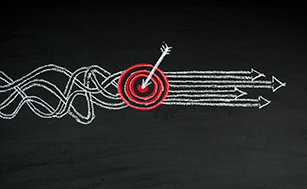5 Ways to Keep Your Time in Check and Your Projects on Track
 How often do you feel like there aren’t enough hours in the day to do everything you need to do? How often do you get in the groove of a project or task, only to be interrupted by an office drop-by, an incoming phone call, an “urgent” email, or a beep, buzz or chime on your cell phone?
How often do you feel like there aren’t enough hours in the day to do everything you need to do? How often do you get in the groove of a project or task, only to be interrupted by an office drop-by, an incoming phone call, an “urgent” email, or a beep, buzz or chime on your cell phone?
Dozens of different tasks can demand our attention at any given point, and while we may try to multitask to get them all done, that modus operandi typically ends up being counterproductive.
In two articles in a recent issue of CUPA-HR’s The Higher Education Workplace magazine, the authors offer advice on how to cut down on distractions and avoid time sucks in order to make the most of the time you have to get things done.
Here are five ways you can take back your time and start making a dent in your to-do list:
1) Chunk your time. In his article “The Multitasking Mirage,” author Scott Blades suggests that rather than switching between multiple activities every few minutes, you should set aside chunks of time to focus on a specific task or a group of related tasks. An example of this would be to set aside 20 minutes to pay all of your bills at once rather than pay each one separately as you receive it. Or maybe you set aside an hour to work on that report you need to present at next week’s meeting. “Focusing on a task for 20 minutes at a time or longer will allow you to get into the zone of whatever you’re doing and make progress,” he says.
2) Minimize distractions in your workspace. Blades also suggests being cognizant of distractions, especially the ones you can control. Some examples he offers: Does your email client issue sound alerts when you receive messages? If so, consider muting your computer while you’re working on a task. Does your smartphone have a bunch of chirps, chimes and ringtones for every notification you receive from your apps? Research shows that the average person checks his or her phone 150 times a day. Unless you need to rely on your smartphone to do your job, you should consider minimizing or disabling the distracting notifications you receive or keeping your phone on mute.
3) Set clear priorities. Another tactic Blades suggests is to prioritize your to-do list. “A guaranteed way to become overwhelmed and ineffective is to take on too much work and view all of your tasks as equal priorities,” he says. He suggests working with your supervisor or a trusted colleague to help you determine what needs your focus now, what can wait, and what you can release altogether.
4) Practice deep work. In his article “Defending Your Galaxy Against the Supervillains of Distractions,” Darrell Easley makes the case for “deep work.” Citing research by Cal Newport, Easley describes four ways philosophies for deep work, including the “rhythmic” approach, which consists of setting aside a consistent timeframe every day or every week to do certain tasks, and the “journalistic” approach, which involves shifting to meaningful work when time presents itself.
5) Create rituals around work. Easley suggests that when we create rituals around our work, we’re more likely to stick to it. Says Easley, “Decide beforehand where you will work and for how long. Will you allow yourself to access the internet while working? Some projects may not require it, and some may. Will you turn off your ringer or switch your office phone mode to ‘unavailable’? Maybe you close out of Outlook for two hours while you focus on a certain task. Maybe you schedule brain breaks for 15 minutes in the morning and 15 minutes in the afternoon.”
Distractions and “emergencies” are all too common in our workdays. They’re also a time drain, an energy sapper and a derailment of productivity. By using the strategies laid out here to make conscious decisions to focus on the task at hand, you’ll be surprised at how quickly you’re able to blow through that to-do list.
Need help keeping that project moving? Check out the new Project Management toolkit in CUPA-HR’s Knowledge Center.


